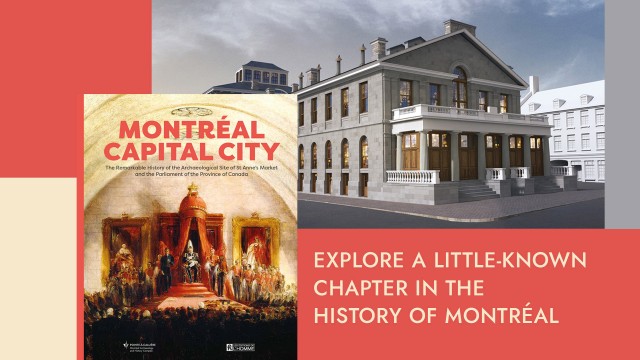February, 2021
"Montréal. Capital City" is now available in English

Press release
Montréal. Capital City
The remarkable History of the Archaeological Site of St. Anne’s Market and the Parliament of the Province of Canada
A major publication that reveals a little-known chapter of history when Montreal was the capital of Canada.
The English version is available starting February 16, 2022 both from our online store and at the Museum reception desk
Montréal, February 16, 2022 – Pointe-à-Callière, Montréal’s Archaeology and History Complex, and Éditions de l'Homme present Montréal. Capital City, a beautifully illustrated book that shines a light on a little-known chapter of Canadian history during a time when Montréal was its capital. Released in French on December 1, 2021, it is now available in English from the online store and at the Museum's reception desk.
Discover the secrets of an archaeological site of national importance
Just a few steps from the Museum, in the heart of Old Montréal, on Place D’Youville West, there once stood an iconic 19th-century building that in turn housed St. Anne’s Market—Montréal’s first covered market (1832-1843)—and the Parliament of the Province of Canada (1844-1849), before it was burned down in the wake of rioting.
Carrying out archaeological digs at the site between 2010 and 2017, Pointe-à-Callière was able to unearth over 350,000 artifacts that survived the flames. The book presents close to a hundred of the most significant of these objects, shedding new light on daily life in the parliament and on 19th-century Montréal, the capital of Canada at the time. This was a defining period for the development of democracy in our country!
The book brings this major site to life with detailed 3D reconstructions of the market and the parliament as well as maps and old illustrations, many of which are being published for the very first time.
Thanks to the combined perspectives of twenty authors, archaeologists and experienced historians, Montréal. Capital City is a true resource that synthesizes the latest knowledge on the subject. A rich trove of anecdotes and historical facts that continue to resonate in society today, Montréal, Capital City is a must-have resource for anyone who is passionate about the history of the city and of Canada.
Montréal, Canada’s capital between 1844 and 1849: a turning point in the nation’s history
During the short period when Montréal served as the nation’s capital, many crucial political decisions for the country were made in the huge building that stood in Place D'Youville.
Between 1834 and 1843, St. Anne’s market was a key meeting place where Montréal's cultural community gave concerts, balls and lectures and where political groups held its meetings. The market is also where the Société Saint-Jean-Baptiste first met and where the Black community of Montreal celebrated the abolition of slavery in 1834.
After the Acts of Union were signed in 1841, the colony’s government was given greater power over domestic affairs: this was the advent of Responsible Government and a pivotal point in the emergence of a democratic government in Canada. In Montréal in 1848, Governor General Lord Elgin fully recognized this principle of Responsible Government with the election of the Reform Party, led by Louis-Hippolyte LaFontaine and Robert Baldwin. This event would lead to the birth of the Canadian Confederation. It was also in Montréal and again in 1848 that the French language was recognized as an official language in Parliament along with English.
This key period ended with the burning of the Parliament on April 25, 1849, by the Tories, who opposed the law compensating the victims of the 1837-38 rebellions (i.e., Les Patriotes). The Parliament was then temporarily moved to Toronto.
About Pointe-à-Callière, Montréal’s Archaeology and History Complex
Pointe-à-Callière, the birthplace of Montréal, is the city’s largest history museum. Rising above a number of national historic and archaeologic sites, the Museum’s mission is to raise awareness and foster an appreciation of the city’s history and to forge bonds with regional, national and international networks.
Pointe-à-Callière, proud partner of Ville de Montréal.
Montréal. Capital City: The remarkable History of the Archaeological Site of St. Anne’s Market and the Parliament of the Province of Canada
A beautifully illustrated coffee-table book edited by Louise Pothier, Chief Archaeologist at Pointe-à-Callière, Montréal’s Archaeology and History Complex, and published by Éditions de l’Homme.
240 pages
Prix : $46.95
“Few people today remember that Montréal was actually the capital of Canada from 1844 to 1849–or, more accurately, the capital of the ‘Province of Canada,’ as the British government had named its colony.
“Parliament at the time sat in an imposing greystone building, erected in 1834 atop a small canalized river, then renovated: the former St. Anne's Market. The cries of butchers, fishmongers and greengrocers in the public market were replaced by the subdued scratching of functionaries' quills on parchment and, just upstairs, the occasionally raucous debates by members of the Legislative Assembly or the Legislative Council. But on the evening of April 25, 1849, the roar of flames was heard instead, as rioters burned down the building!
“These different lives of what is now part of Place D'Youville, in Old Montréal, remained hidden underground until archaeological excavations brought them back to light.
“Now you can relive this little-known episode of the history of Montréal, Québec and Canada, a surprising, exciting and eventful story told in this collective work by dedicated historians and archaeologists brought together by Pointe-à-Callière.”
-30-
Contact us for media requests or interviews with Louise Pothier, Pointe-à-Callière's chief archaeologist, or the other co-authors of the book.
Source :
Nora Charifi
Project Manager, Communications
Pointe-à-Callière
Phone: 514-872-2687 / Cell: 514-829-0955
[email protected]
